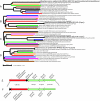Insights on evolution of virulence and resistance from the complete genome analysis of an early methicillin-resistant Staphylococcus aureus strain and a biofilm-producing methicillin-resistant Staphylococcus epidermidis strain
- PMID: 15774886
- PMCID: PMC1065214
- DOI: 10.1128/JB.187.7.2426-2438.2005
Insights on evolution of virulence and resistance from the complete genome analysis of an early methicillin-resistant Staphylococcus aureus strain and a biofilm-producing methicillin-resistant Staphylococcus epidermidis strain
Abstract
Staphylococcus aureus is an opportunistic pathogen and the major causative agent of numerous hospital- and community-acquired infections. Staphylococcus epidermidis has emerged as a causative agent of infections often associated with implanted medical devices. We have sequenced the approximately 2.8-Mb genome of S. aureus COL, an early methicillin-resistant isolate, and the approximately 2.6-Mb genome of S. epidermidis RP62a, a methicillin-resistant biofilm isolate. Comparative analysis of these and other staphylococcal genomes was used to explore the evolution of virulence and resistance between these two species. The S. aureus and S. epidermidis genomes are syntenic throughout their lengths and share a core set of 1,681 open reading frames. Genome islands in nonsyntenic regions are the primary source of variations in pathogenicity and resistance. Gene transfer between staphylococci and low-GC-content gram-positive bacteria appears to have shaped their virulence and resistance profiles. Integrated plasmids in S. epidermidis carry genes encoding resistance to cadmium and species-specific LPXTG surface proteins. A novel genome island encodes multiple phenol-soluble modulins, a potential S. epidermidis virulence factor. S. epidermidis contains the cap operon, encoding the polyglutamate capsule, a major virulence factor in Bacillus anthracis. Additional phenotypic differences are likely the result of single nucleotide polymorphisms, which are most numerous in cell envelope proteins. Overall differences in pathogenicity can be attributed to genome islands in S. aureus which encode enterotoxins, exotoxins, leukocidins, and leukotoxins not found in S. epidermidis.
Figures




References
-
- Archer, G. L., and D. M. Niemeyer. 1994. Origin and evolution of DNA associated with resistance to methicillin in staphylococci. Trends Microbiol. 2:343-347. - PubMed
-
- Baba, T., F. Takeuchi, M. Kuroda, H. Yuzawa, K. Aoki, A. Oguchi, Y. Nagai, N. Iwama, K. Asano, T. Naimi, H. Kuroda, L. Cui, K. Yamamoto, and K. Hiramatsu. 2002. Genome and virulence determinants of high virulence community-acquired MRSA. Lancet 359:1819-1827. - PubMed
-
- Beres, S. B., G. L. Sylva, K. D. Barbian, B. Lei, J. S. Hoff, N. D. Mammarella, M. Y. Liu, J. C. Smoot, S. F. Porcella, L. D. Parkins, D. S. Campbell, T. M. Smith, J. K. McCormick, D. Y. Leung, P. M. Schlievert, and J. M. Musser. 2002. Genome sequence of a serotype M3 strain of group A Streptococcus: phage-encoded toxins, the high-virulence phenotype, and clone emergence. Proc. Natl. Acad. Sci. USA 99:10078-10083. - PMC - PubMed
-
- Centers for Disease Control and Prevention. 1999. Four pediatric deaths from community-acquired methicillin-resistant Staphylococcus aureus—Minnesota and North Dakota, 1997-1999. Morb. Mortal. Wkly. Rep. 48:707-710. - PubMed
Publication types
MeSH terms
Associated data
- Actions
- Actions
- Actions
- Actions
Grants and funding
LinkOut - more resources
Full Text Sources
Other Literature Sources
Molecular Biology Databases
Miscellaneous

